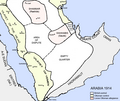Portal:Saudi Arabia
The Saudi Arabia Portal – بوابة المملكة العربية السعودية
Saudi Arabia, officially the Kingdom of Saudi Arabia (KSA), is a country in West Asia and the Middle East. It covers the bulk of the Arabian Peninsula and has a land area of about 2150000 km2 (830000 sq mi), making it the fifth-largest country in Asia and the largest in the Middle East. It is bordered by the Red Sea to the west; Jordan, Iraq, and Kuwait to the north; the Persian Gulf, Qatar and the United Arab Emirates to the east; Oman to the southeast; and Yemen to the south. Bahrain is an island country off its east coast. The Gulf of Aqaba in the northwest separates Saudi Arabia from Egypt and Israel. Saudi Arabia is the only country with a coastline along both the Red Sea and the Persian Gulf, and most of its terrain consists of arid desert, lowland, steppe, and mountains. The capital and largest city is Riyadh; the kingdom also hosts Islam's two holiest cities of Mecca and Medina. (Full article...) Selected article -Hegra (Ancient Greek: Ἕγρα, Arabic: ٱلْحِجْر, romanized: al-Ḥijr), also known as Mada’in Salih (Arabic: مَدَائِن صَالِح, romanized: madāʼin Ṣāliḥ, lit. 'Cities of Salih'), is an archaeological site located in the area of Al-'Ula within Medina Province in the Hejaz region, Saudi Arabia. A majority of the remains date from the Nabataean Kingdom (1st century AD). The site constitutes the kingdom's southernmost and second largest city after Petra (now in Jordan), its capital city. Traces of Lihyanite and Roman occupation before and after the Nabatean rule, respectively, can also be found. The archaeological site lies in an arid environment. The dry climate, the lack of resettlement after the site was abandoned, and the prevailing local beliefs about the locality have all led to the extraordinary state of preservation of Al-Hijr, providing an extensive picture of the Nabatean lifestyle. Thought to mark the southern extent of the Nabatean kingdom, Al-Hijr's oasis agriculture and extant wells exhibit the necessary adaptations made by the Nabateans in the given environment—its markedly distinct settlement is the second largest among the Nabatean kingdom, complementing that of the more famous Petra archaeological site in Jordan. The location of the site at the crossroads of trade, as well as the various languages, scripts and artistic styles reflected in the façades of its monumental tombs further set it apart from other archaeological sites. It has duly earned the nickname "The Capital of Monuments" among Saudi Arabia's 4,000 archaeological sites. (Full article...)Did you know (auto-generated)
News
Related portalsReligions in Saudi Arabia Arab states WikiProjectsThings you can do
This is a Good article, an article that meets a core set of high editorial standards.
 Foreign workers in Saudi Arabia (Arabic: العَمالَة الأَجْنَبِيَّة فِي السَعُودِيَّة, romanized: al-ʿamālah al-ʾāǧnabīyah fī as-Saʿūdīyah), estimated to number about 9 million as of April 2013, began migrating to the country soon after oil was discovered in the late 1930s. Initially, the main influx was composed of Arab and Western technical, professional and administrative personnel, but subsequently substantial numbers came from Southeast Asia. Saudi Arabia has become increasingly dependent on foreign labour, and although foreign workers remain present in technical positions, most are now employed in the agriculture, cleaning and domestic service industries. The hierarchy of foreign workers is often dependent on their country of origin; workers from Arab nations and western nations generally hold the highest positions not held by Saudis, and the lower positions are occupied by persons from Africa, and Southeast Asia. The Saudi government has faced criticism from legal bodies and employers over the treatment of foreign workers. Saudi Arabia deported thousands of Tigrayan migrants to Ethiopia after holding them unlawfully for six months to six years in formal and informal detention facilities across the kingdom. The Tigrayan migrants were brutally tortured while being unjustly held in Saudi prisons. (Full article...)Selected pictureMore did you know
General imagesThe following are images from various Saudi Arabia-related articles on Wikipedia.
Featured contentFeatured articlesGood articles
Associated WikimediaThe following Wikimedia Foundation sister projects provide more on this subject:
Sources
Discover Wikipedia using portals | ||||








![Image 3A view of Jabal Sawda, a peak located in Saudi Arabia, with an elevation of around 3,000 metres (9,843 ft).[1]](http://upload.wikimedia.org/wikipedia/commons/thumb/5/59/Al_Sawda_peak.jpg/120px-Al_Sawda_peak.jpg)




















































